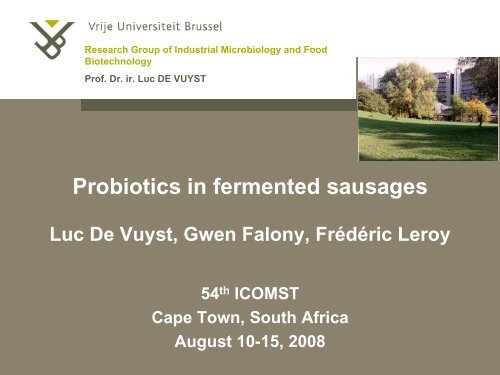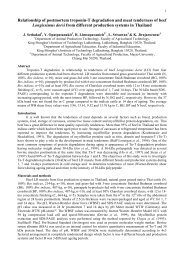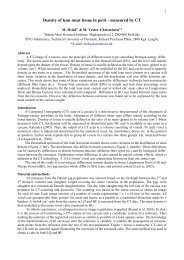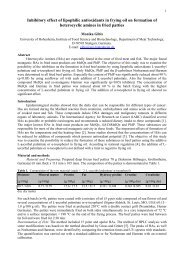Luc De Vuyst.pdf - ICoMST Contact Point
Luc De Vuyst.pdf - ICoMST Contact Point
Luc De Vuyst.pdf - ICoMST Contact Point
You also want an ePaper? Increase the reach of your titles
YUMPU automatically turns print PDFs into web optimized ePapers that Google loves.
Research Group of Industrial Microbiology and Food<br />
Biotechnology<br />
Prof. Dr. ir. <strong>Luc</strong> DE VUYST<br />
Probiotics in fermented sausages<br />
<strong>Luc</strong> <strong>De</strong> <strong>Vuyst</strong>, Gwen Falony, Frédéric Leroy<br />
54 th ICOMST<br />
Cape Town, South Africa<br />
August 10-15, 2008
Outline<br />
• Introduction to functional/probiotic foods<br />
• Probiotics<br />
• Important considerations<br />
• Probiotics in fermented meat products<br />
• Conclusions
Outline<br />
• Introduction to functional/probiotic foods<br />
- <strong>De</strong>finition functional food<br />
- <strong>De</strong>finition probiotics<br />
- <strong>De</strong>finition probiotic meat products<br />
• Probiotics<br />
• Important considerations<br />
• Probiotics in fermented meat products<br />
• Conclusions
Introduction – Functional foods<br />
A functional food is a food for which it has been satisfactorily<br />
demonstrated that it beneficially affects one or more target functions in<br />
the body, beyond adequate nutritional effects, in a way that is relevant to<br />
either an improved state of health and well-being and/or reduction of risk<br />
of disease (Diplock et al., 1999).<br />
Relationship food-health:<br />
Hippocrates – Nutrition (balanced diet) – Health (health-promoting diet) –<br />
Nutrigenomics<br />
Medicine or drug: something you take when you are ill<br />
Functional food: the healthy food you eat throughout your life<br />
and which in many cases will protect you from otherwise<br />
life-threatening diseases
Introduction – Functional foods<br />
A functional food is a food for which it has been satisfactorily<br />
demonstrated that it beneficially affects one or more target functions in<br />
the body, beyond adequate nutritional effects, in a way that is relevant to<br />
either an improved state of health and well-being and/or reduction of risk<br />
of disease (Diplock et al., 1999).<br />
Relationship food-health:<br />
First generation:<br />
- focussed on the traditional, nutritional value of a food<br />
- deal with the application of primary nutrients and nutritional claims<br />
- aim is to avoid deficiencies and to optimise a normal diet<br />
- e.g. natural foods (fruits and vegetables, dairy products),<br />
diet margarine
Relationship food-health:<br />
Second generation:<br />
Introduction – Functional foods<br />
A functional food is a food for which it has been satisfactorily<br />
demonstrated that it beneficially affects one or more target functions in<br />
the body, beyond adequate nutritional effects, in a way that is relevant to<br />
either an improved state of health and well-being and/or reduction of risk<br />
of disease (Diplock et al., 1999).<br />
- focuses on effects beyond the traditional, nutritional value of a food<br />
- deal with application of secondary nutrients and health claims<br />
- aim is to optimise nutrition of a healthy diet and to focus on<br />
health-promoting effects<br />
- e.g. fibre-, calcium-, vitamin- and ω3-enriched foods<br />
diet margarine with added phytosterols<br />
hypoallergenic rice<br />
gluten-free bread<br />
probiotics, prebiotics, and synbiotics
Introduction - Probiotics<br />
Probiotics (προ βίος, pro bios, ‘for life’) are live microorganisms that, when<br />
consumed in an adequate amount as part of the food, confer a health<br />
benefit on the host (FAO/WHO, 2001).<br />
Long history:<br />
Elias Metchnikoff (1907/1908): “The prolongation of life”<br />
Minoru Shirota (1930): Lactobacillus casei Shirota<br />
Parker (1974): animal feed supplements with a beneficial<br />
effect on the host by contributing to its intestinal microbial<br />
balance<br />
Fuller (1989): live, microbial feed supplements, which<br />
beneficially affect the host animal by improving its intestinal<br />
microbial balance<br />
Havenaar & Huis in ‘t Veld (1992): viable microorganisms that exhibit a<br />
beneficial effect on the health of the host upon ingestion in sufficient<br />
amounts by improving the properties of its indigenous microbiota<br />
<strong>De</strong> <strong>Vuyst</strong>, Avonts & Makras (2004). Woodhead Publishing, Ltd., Cambridge, UK
Long history:<br />
Introduction - Probiotics<br />
Probiotics (προ βίος, pro bios, ‘for life’) are live microorganisms that, when<br />
consumed in an adequate amount as part of the food, confer a health<br />
benefit on the host (FAO/WHO, 2001).<br />
… animals/humans … properties/functionalities … formulations<br />
FAO/WHO (2001): live microorganisms that, when consumed in an<br />
adequate amount as part of the food, confer a health benefit on the host<br />
ILSI (2002): live, microbial food ingredient that, when taken up in<br />
adequate amounts, confers health benefits on the consumer<br />
EFFCA (2003): live microorganisms, which, when ingested or locally<br />
applied in sufficient numbers, provide the consumer with one or more<br />
proven health benefits<br />
<strong>De</strong> <strong>Vuyst</strong>, Avonts & Makras (2004). Woodhead Publishing, Ltd., Cambridge, UK
Target organs:<br />
Introduction - Probiotics<br />
Probiotics (προ βίος, pro bios, ‘for life’) are live microorganisms that, when<br />
consumed in an adequate amount as part of the food, confer a health<br />
benefit on the host (FAO/WHO, 2001).<br />
digestive tract (colon, small intestine, stomach)<br />
other sites of the body (oral cavity, urogenital tract, skin)<br />
immune system<br />
cardiovascular system<br />
Current delicate points of discussion:<br />
Site of activity (foods or drugs, prevention or curing, …)<br />
Viability (life or dead cells, alive upon ingestion, alive at the site of action, …)<br />
Amount of cells (food product) necessary to exert a specified probiotic effect<br />
Format of intake and carrier [mono- or mixed cultures, food (dairy) products,<br />
food supplements, pharmaceutical preparations, …]<br />
Requirement of oral administration for clinical efficacy<br />
<strong>De</strong> <strong>Vuyst</strong>, Avonts & Makras (2004). Woodhead Publishing, Ltd., Cambridge, UK
Introduction - Probiotics<br />
Probiotics (προ βίος, pro bios, ‘for life’) are live microorganisms that, when<br />
consumed in an adequate amount as part of the food, confer a health<br />
benefit on the host (FAO/WHO, 2001).<br />
Micro-organisms (strains):<br />
Lactic acid bacteria:<br />
- Lactobacillus casei Shirota (YIT 9029, Yakult)<br />
- Lactobacillus casei Imunitass (DN-114 001, Actimel)<br />
- Lactobacillus rhamnosus GG (ATCC 53103, Gefilus, Vifit, …)<br />
- Lactobacillus johnsonii La1 (NCC 533, LC1)<br />
- Lactobacillus plantarum 299v (ProViva)<br />
- Bifidobacterium animalis subsp. lactis Bb12 (various brand names)<br />
- Bifidobacterium animalis subsp. lactis Actiregularis (DN 173-010, Activia)<br />
- Bifidobacterium longum BB 536 (yoghurt, powder)<br />
- VSL#3 (mixture of eight strains, biotherapeutic agent)<br />
Other bacteria: E. coli Nissle 1917 (Mutaflor, biotherapeutic agent)<br />
Yeasts:<br />
- Saccharomyces boulardii (Enterol, biotherapeutic agent)<br />
<strong>De</strong> <strong>Vuyst</strong>, Avonts & Makras (2004). Woodhead Publishing, Ltd., Cambridge, UK
Introduction - Probiotics<br />
A probiotic food is a food that contains probiotics in sufficient quantities<br />
and that exerts beneficial effects on the host beyond its primary<br />
nutritional effect.<br />
PROBIOTICS<br />
as/via<br />
Traditional<br />
Functional<br />
Food<br />
Pharmaceutical<br />
fermented foods<br />
foods<br />
supplements<br />
preparations<br />
Foods of animal or<br />
vegetable origin<br />
fermented with<br />
lactic acid bacteria,<br />
which are consumed<br />
without heat treatment<br />
New type of foods that<br />
contain probiotic lactic<br />
acid bacteria strains that<br />
have been selected on<br />
the basis of specific,<br />
functional properties<br />
(fermented dairy<br />
products, fruit juices, ...)<br />
Probiotic microorganisms that have been<br />
selected on the basis of their specific,<br />
functional properties (powders, tablets,<br />
capsules, …)
Introduction - Probiotics<br />
A probiotic food is a food that contains probiotics in sufficient quantities<br />
and that exerts beneficial effects on the host beyond its primary<br />
nutritional effect.<br />
W. Kneifel
Introduction - Probiotics<br />
A probiotic food is a food that contains probiotics in sufficient quantities<br />
and that exerts beneficial effects on the host beyond its primary<br />
nutritional effect.<br />
Animal feed: 46 %<br />
Dietary supplements:<br />
44 %<br />
Dairy products: 9 %<br />
Other applications:<br />
1 %
Introduction - Probiotics<br />
A probiotic (fermented) meat product is a (fermented) meat product that<br />
contains probiotics in sufficient quantities and that exerts beneficial<br />
effects on the host beyond its primary nutritional effect.<br />
Challenges:<br />
Marketing and re-appreciation of fermented meat products as “healthy foods”<br />
Microbiological, technological, and regulatory aspects<br />
Steps to be taken:<br />
Careful selection of probiotic strains:<br />
- survival of the passage of the upper gastrointestinal tract<br />
- cell viability in a fermented meat matrix<br />
Meat as carrier for probiotic strains:<br />
- resistance towards technological processing<br />
Beneficial health effects of probiotic meat products:<br />
- underlying mechanisms of action<br />
- demonstration of human benefits<br />
<strong>De</strong> <strong>Vuyst</strong>, Falony & Leroy (2008). Meat Science 80, 75-78.<br />
A. Ouwehand
Introduction – Functional foods<br />
A probiotic (fermented) meat product is a (fermented) meat product that<br />
contains probiotics in sufficient quantities and that exerts beneficial<br />
effects on the host beyond its primary nutritional effect.<br />
And also:<br />
- safe<br />
- no disadvantageous effect on texture or taste<br />
- no side effects when correctly used<br />
- no disturbance of the normal eat pattern<br />
- efficient production and payable by everybody<br />
- scientific relevance of potential claims<br />
<strong>De</strong> <strong>Vuyst</strong>, Falony & Leroy (2008). Meat Science 80, 75-78.<br />
A. Ouwehand
Outline<br />
• Introduction to functional/probiotic foods<br />
• Probiotics<br />
- Selection criteria<br />
- Health effects<br />
- Mechanisms of action<br />
• Important considerations<br />
• Probiotics in fermented meat products<br />
• Conclusions
<strong>De</strong> <strong>Vuyst</strong>, Avonts & Makras (2004). Woodhead Publishing, Ltd., Cambridge, UK<br />
Important criteria for probiotics<br />
Probiotics: selection criteria<br />
- Human origin and non-pathogenic behaviour<br />
- Survive passage through the upper gastrointestinal tract<br />
- resistance to gastric acid and bile toxicity, digestive enzymes, …<br />
- active during transit from stomach to colon (expression of genes during intestinal<br />
transit)<br />
- Interact with the resident microbiota<br />
- ability to transiently adhere to or interact with the intestinal epithelium and colonize the<br />
colon<br />
- do not affect the dominant microbiota significantly<br />
- have an effect on the numbers and diversity of the endogenous Lactobacillus and<br />
Bifidobacterium species<br />
- Affect the function of the host:<br />
- probiotic-host interactions (functional genomics, clinical trials and human intervention<br />
studies)<br />
- prevention of (the risk on) disease (meta-analyses)<br />
- Resistant towards technological processing and storage<br />
- importance of the food matrix and the applied process technology<br />
- stable/alive till the moment of consumption (the number of live, active cells is<br />
important)<br />
- High safety profile and excellent tolerance (Lb. rhamnosus, D-lactic acid)
Probiotics: health effects<br />
Classification according to scientific evidence<br />
- improved food digestion (e.g. proteins, dietary polysaccharides)<br />
- reduction of the risk of lactose maldigestion (β-galactosidase)<br />
- supply and bioavailability of nutrients and growth factors (e.g. vitamins, minerals)<br />
- maintenance and balancing of the colon microbiota<br />
- reduction of (the risk of) intestinal disturbances (gastrointestinal infections,<br />
constipation)<br />
- reduction of the risk and duration of diarrhoea (rotavirus diarrhoea, acute<br />
infectious diarrhoea, antibiotic-associated diarrhoea, Clostridium difficileassociated<br />
diarrhoea, travellers’ diarrhoea)<br />
- inhibition of undesirable and pathogenic bacteria (orogastrointestinal infections<br />
caused by Streptococcus mutans, Helicobacter pylori, E. coli, Salmonella<br />
Typhimurium, Clostridium difficile, Shigella flexneri, urinary tract infections,<br />
respiratory tract infections)
Probiotics: health effects<br />
- modulation/stimulation of the immune system (cell-mediated and antibodymediated<br />
effects)<br />
- reduction of the risk of atopic diseases and allergies (asthma, hay fever, food<br />
allergy, eczema, dermatitis)<br />
- beneficial effects on functional bowel disorders: irritable bowel syndrome<br />
- beneficial effects on inflammatory bowel diseases: pouchitis, ulcerative colitis,<br />
Crohn’s disease<br />
- anticarcinogenic activities<br />
- lowering of blood serum cholesterol levels<br />
(<strong>De</strong> <strong>Vuyst</strong>, Avonts & Makras (2004). Woodhead Publishing, Ltd.; Servin & Coconnier (2004). Best Pract. Res.<br />
Gastroenterol.; Servin (2004). FEMS Microbiol. Rev.; Rastall et al. (2005). FEMS Microbiol. Ecol.;<br />
Saxelin et al. (2005). Curr. Opinion Biotechnol.; O’Hara & Shanahan (2007). Scientific World Journal;<br />
Galdeano et al. (2007). Clin. Vaccine Immunol.)
Probiotics: mechanism of action<br />
1. Probiotics influence microbe-microbe interactions<br />
- Competition for nutrients available in the gut lumen<br />
- Production of antimicrobial or toxic agents modifying the local<br />
microenvironment and hence contributing to survival<br />
2. Probiotics influence microbe-gut epithelium interactions<br />
- Competitive exclusion along the epithelium<br />
- Enhancement of the epithelial barrier function<br />
- Suppression of intestinal inflammation<br />
3. Probiotics influence microbe-immune system interactions and<br />
modulate the host immune response<br />
- Cell-mediated immune responses<br />
- Humoral (antibody-mediated) and innate immune responses<br />
(<strong>De</strong> <strong>Vuyst</strong>, Avonts & Makras (2004). Woodhead Publishing, Ltd.; Servin & Coconnier (2004). Best Pract. Res.<br />
Gastroenterol.; Servin (2004). FEMS Microbiol. Rev.; Rastall et al. (2005). FEMS Microbiol. Ecol.;<br />
Saxelin et al. (2005). Curr. Opinion Biotechnol.; O’Hara & Shanahan (2007). Scientific World Journal;<br />
Galdeano et al. (2007). Clin. Vaccine Immunol.)
Outline<br />
• Introduction to functional/probiotic foods<br />
• Probiotics<br />
• Important considerations<br />
• Probiotics in fermented meat products<br />
• Conclusions
Important considerations<br />
Health-promoting properties/mechanisms are STRAIN-SPECIFIC and<br />
MATRIX-DEPENDENT<br />
Not all strains of a given species possess the health-promoting<br />
properties/mechanisms of action of a probiotic strain of that species.<br />
Also, not all probiotic strains possess all health-promoting properties.<br />
However, mechanisms of action are often multifactorial and are not<br />
mutually exclusive.<br />
Good examples are (target applications, cf. Table 1):<br />
- Lactobacillus casei Shirota (YIT 9029) Yakult<br />
- Lactobacillus casei Imunitass (DN-114 001) Actimel<br />
- Lactobacillus rhamnosus GG (ATCC 53103) Gefilus, Vifit, …<br />
- Lactobacillus jonhsonii La1 (NCC 533) LC1<br />
- Lactobacillus plantarum 299v Provie<br />
- Bifidobacterium animalis subsp. lactis Bb12 several products<br />
- Bifidobacterium animalis subsp. lactis DN 173-010 Activia<br />
- Bifidobacterium longum BB 536 yoghurt, powder<br />
- … <strong>De</strong> <strong>Vuyst</strong>, Avonts & Makras (2004). Woodhead Publishing, Ltd., Cambridge, UK
Important considerations<br />
Health-promoting properties/mechanisms are STRAIN-SPECIFIC and<br />
MATRIX-DEPENDENT<br />
Efficacy of a probiotic strain depends on the food matrix (meat matrix?)<br />
And further depends on:<br />
- culture conditions of the strain<br />
- dose and frequency of ingestion<br />
of the strain/product<br />
- target group characteristics<br />
- children, adults, or elderly<br />
- pregnant women<br />
- healthy volunteers vs diseased people INDIVIDUAL-<br />
- immunocompromised people DEPENDENT!<br />
- normal gut transit vs constipated persons<br />
- standard vs normal diet<br />
- … <strong>De</strong> <strong>Vuyst</strong>, Avonts & Makras (2004). Woodhead Publishing, Ltd., Cambridge, UK
Important considerations<br />
Health-promoting properties/mechanisms are STRAIN-SPECIFIC and<br />
MATRIX-DEPENDENT<br />
Unfortunately:<br />
- misuse of the probiotic concept by food manufacturers, in particular by<br />
not specifying the probiotic strain used, which indicates the need for a<br />
correct typing and food labelling plus freely accessible easy-tounderstand<br />
documentation<br />
- no bacteria present, other bacteria present, or no viable bacteria<br />
present at the time of consumption (Temmerman et al., 2003a,b)<br />
- no safety evaluation (use of species known to be at the borderline of<br />
causing disease)<br />
- no demonstration of health-promoting effects<br />
<strong>De</strong> <strong>Vuyst</strong>, Avonts & Makras (2004). Woodhead Publishing, Ltd., Cambridge, UK
<strong>De</strong> <strong>Vuyst</strong>, Avonts & Makras (2004). Woodhead Publishing, Ltd., Cambridge, UK<br />
Important considerations<br />
STRAIN IDENTIFICATION and SCIENTIFIC VALIDATION OF HEALTH-<br />
PROMOTING EFFECTS<br />
Health benefits of a certain probiotic strain belonging to a certain species<br />
can not be extrapolated to strains of the same or another species:<br />
importance of strain identification!<br />
Health benefits should be scientifically supported:<br />
- mutants and in vitro and in vivo models as tools<br />
- well-designed, randomized, double-blind, placebo-controlled clinical trials<br />
or human intervention studies: importance of multi-centre research, peerreviewed<br />
publications<br />
Health-supporting claims should be technically well characterized:<br />
identified product (matrix dependency)<br />
effect observed in humans (target group dependency)<br />
dose/effect relationship (cell count plus amount of product)<br />
relevant biomarkers to measure the efficacy for improved functions or for<br />
risks of diseases.
Outline<br />
• Introduction to functional/probiotic foods<br />
• Probiotics<br />
• Important considerations<br />
• Probiotics in fermented meat products<br />
• Conclusions
Probiotics: selection criteria<br />
Fermented meat as a carrier for probiotic bacteria<br />
+ - Usually not or only mildly heated<br />
- Protection of the survival of probiotic lactic acid bacteria through<br />
the gastrointestinal tract<br />
- - High content in curing salt<br />
- Low pH (acidification) → affects cell viability<br />
- Low a w (drying) (strain-dependent!)<br />
<strong>De</strong> <strong>Vuyst</strong>, Falony & Leroy (2008). Meat Science 80, 75-78.
Careful selection of strains<br />
1. Screening natural sausage isolates<br />
Probiotics: selection criteria<br />
- Lb. gasseri JCM 1131 T Arihara et al., 1998<br />
- Lb. sakei RM10, P. pentosaceus P2 Erkkilä & Petäjä, 2000<br />
- Lb. sakei, Lb. curvatus, Lb. plantarum strains Papamanoli et al., 2003<br />
- Lb. plantarum strains Pennacchia et al., 2004, 2006<br />
- Lb. plantarum/pentosus Klingberg et al., 2005<br />
- Staphylococcus spp. strains Villani et al., 2005<br />
Paramithiotis et al., 2006<br />
- Lb. casei, Lb. paracasei, Lb. rhamnosus, Lb. sakei Rebucci et al., 2007<br />
2. Screening existing commercial meat starter cultures<br />
- Lb. sakei Lb3, P. acidilactici PA-2 Erkkilä & Petäjä, 2000<br />
- Lb. acidophilus LAFTI ® L10 Mahoney & Henriksson, 2003<br />
+ - <strong>De</strong>monstration of physiological requirements<br />
- <strong>De</strong>monstration of technological effectiveness<br />
- - <strong>De</strong>monstration of health-promoting properties<br />
<strong>De</strong> <strong>Vuyst</strong>, Falony & Leroy (2008). Meat Science 80, 75-78.
Careful selection of strains<br />
Probiotics: selection criteria<br />
Survival of L. reuteri ATCC 55730 (SD2112) during the manufacture of<br />
dry fermented sausages (● — unencapsulated L. reuteri, ■ — L. reuteri<br />
microencapsulated by extrusion, and — L. reuteri microencapsulated by<br />
emulsion).<br />
Muthukumarasamy & Holley (2006) IJFM, 164-169
Careful selection of strains<br />
1. Screening natural sausage isolates<br />
Probiotics: selection criteria<br />
2. Screening existing commercial meat starter cultures<br />
3. Testing strains with documented health-promoting properties<br />
e.g. Lb. rhamnosus GG (Erkkilä et al., 2001a,b)<br />
- Competition with the natural meat microbiota in an environment which is not their<br />
natural habitat<br />
- Survival of the fermentation and drying process<br />
- Survival of refrigeration and storage conditions<br />
- Ability to grow to numbers that enable the display of health-promoting effects<br />
+ - Survival of the added species in the meat matrix<br />
- Influence on technological and sensory characteristics of the final<br />
products<br />
- - <strong>De</strong>monstration of health effects<br />
<strong>De</strong> <strong>Vuyst</strong>, Falony & Leroy (2008). Meat Science 80, 75-78.
Careful selection of strains<br />
Probiotics: selection criteria<br />
Cell count [log cfu/g]<br />
8<br />
6<br />
4<br />
2<br />
0<br />
HOWARU Rhamnosus<br />
Staphylococcus xylosus<br />
0 5 10 15 20<br />
Ripening time [days]<br />
A. Ouwehand
Careful selection of strains<br />
Probiotics: selection criteria<br />
Flavour profiles of dry sausages fermented by different strains.<br />
Erkkilä et al. (2001). Meat Science 58, 111-116
Food safety enhancement<br />
Probiotics: selection criteria<br />
- Lb. reuteri ATCC 55730 + B. longum ATCC 15708<br />
- Lb. rhamnosus GG<br />
derease of E. coli 0157:H7<br />
Muthukumarasamy & Holley, 2007<br />
Erkkilä et al., 2000<br />
- Lb. gasseri JCM 1131 T<br />
- Lb. rhamnosus FERM P-15120 + Lb. paracasei subsp. paracasei FERM<br />
P-15121<br />
decrease of growth and enterotoxin production of Staphylococcus aureus<br />
Arihara et al., 1998<br />
Sameshima et al., 1998<br />
- Lb. acidophilus LAFTI ® L10<br />
anti-Listeria activity<br />
Pidcock et al., 2002<br />
Mahoney & Henriksson, 2003<br />
<strong>De</strong> <strong>Vuyst</strong>, Falony & Leroy (2008). Meat Science 80, 75-78.
Probiotics: selection criteria<br />
Human studies using probiotic fermented meat<br />
products<br />
- Lb. paracasei LTH 2579 immmunity +<br />
blood serum lipids -<br />
<strong>De</strong>sign of the intervention study<br />
Jahreis et al. (2002). FRI 35, 133-138.<br />
CD4 (T-helper) lymphocytes in<br />
volunteers in relation to the numbers<br />
of Lb. paracasei in faeces (significant<br />
increase for some but not all<br />
volunteers).
Probiotics: selection criteria<br />
Human studies using probiotic fermented meat<br />
products<br />
- Lb. paracasei LTH 2579 immmunity +<br />
blood serum lipids -<br />
<strong>De</strong>sign of the intervention study<br />
Jahreis et al. (2002). FRI 35, 133-138.<br />
CD54 (ICAM-1, intercellular<br />
molecule of adhesion for cell<br />
cooperation) in volunteers with<br />
different counts of Lb. paracasei in<br />
faeces.
Outline<br />
• Introduction to functional/probiotic foods<br />
• Probiotics<br />
• Important considerations<br />
• Probiotics in fermented meat products<br />
• Conclusions
Conclusions<br />
• The health-promoting, functional food market is a growing<br />
market.<br />
• Probiotics play an important role in gut health.<br />
• Health-promoting properties are strain-/product-specific,<br />
matrix-dependent, and individual-dependent.<br />
• Food manufacturers should apply a careful strain selection<br />
and correct labelling.<br />
• Mechanisms of action are becoming elucidated.<br />
• Health claims should be supported by scientific studies<br />
(mechanistic studies, human trials, ...).<br />
• More research is needed to justify the launch of new<br />
probiotics in general and of probiotic fermented sausages in<br />
particular, particularly with respect to human studies.
Acknowledgements<br />
• Research Council of the Vrije Universiteit<br />
Brussel (OZR, BOF)<br />
• Fund for Scientific Research – Flanders<br />
• Institute for the Promotion of Science and<br />
Technology in Flanders (IWT-GBOU-010054,<br />
IWT-040815, IWT-070029)<br />
• Ministry of the Flemish Community (AWI)<br />
• European Commission (QLK1-CT-2001-<br />
01179-PROPATH)<br />
• National and international food companies<br />
(Imperial Meat Products, Danone, Orafti,<br />
Yakult, ...)
Thank you !













